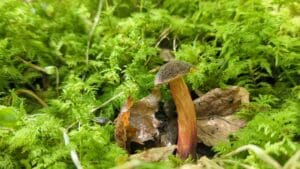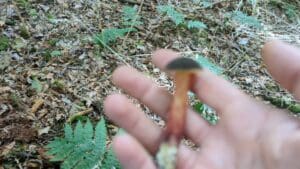Matt Bolete Mushroom / Summer / Autumn / Edible
The Matt Bolete mushroom is a delightful little fungi to find and it could potentially be confused with as number of other smaller boletes you don’t need to panic as none of them are toxic which is always a nice thing to learn.
Scientific Name
Xerocomellus Pruinatus ( syn. Boletus pruinatus)
Family
Boletaceae
Habitat
Mixed deciduous woodland particularly Beech showing a strong preference for chalk soils seen late summer and autumn.
Reasonably common in the UK
Matt Bolete Mushroom Foraging Video
Description
A fairly beginner friendly edible mushroom, looking rather more small and slender than its prized cousin the porcini, but still very recognisable as a bolete.
Identifying Features of the Matt Bolete Mushroom
Cap:
Mid to dark brown, very matt as the name suggests, finely felty. Non cracking.
4-8 cm Hemispherical and becoming convex then flatter with age.
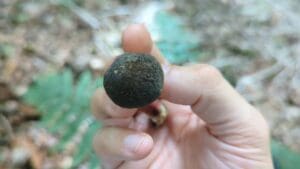
Stem:
The stem (stipe) 4-10cm, often longer than the cap is wide.
Yellow with areas of red compose of tiny dots. The red is usually concentrated at the middle or base and yellow where the stem attaches to the cap.
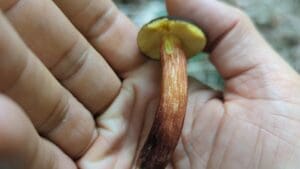
Flesh:
Firm, thick and light yellow in colour, can turn slightly blue when cut but not a strongly staining bolete.
Underside (fertile)
This is a polypore fungi- 100s of Pores (tiny holes) on the underside of the cap which are yellow turning mustard colour with age. The pores (visible) are the end of tubes, which you can see if you cut a cross section of the cap. A feature of all boletes is that you can gently peel the pore layer away from the cap.
When bruised the pores can turn a green/ blue
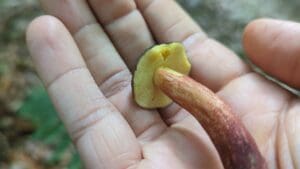
Smell:
Mild, pleasant mushroom scent
Spores:
Olivaceous brown
Known hazards
None known.
Potential lookalikes
Size and shape are important to not get this one mixed with with larger stockier boletes that display red and have blue staining.
Many other small boletes look very similar none of which are toxic, the key feature to differentiate them is the cap. Many are a similar shape and size and the stem also with varying tones of red with dots, but with different colour and textures on the cap
Red cracking bolete xerocomellus chrysenteron: Has a cracking cap exposing a red colouration
Sepia bolete boletus porosporus: has a cracking cap deposing a light yellow flesh
Ruby bolete: Hortiboletus rubellus: very similar but with a reddish brown cap and not so matt.
Uses for the Matt Bolete Mushroom
In food
A decent edible mushroom, being fairly small and not often fruiting in large numbers can be insubstantial but good for adding with a mushroom mix.
Boletes unless young and firm can have a tendency to have a bit of a soggy texture if cooked in wet dishes. Cooking them in a little butter until the juices have fried off keeps the texture firmer and tender.
Boletes are fairly susceptible to burrowing grubs which are of no harm but everyone has their acceptable ratio. I cut a little slice of the stem and cap to make sure they are not full of them past being usable. If they are better to leave them in the woodland for insects and animals to eat.
Can be used to make up the number of Ceps in a recipe
Sources
https://www.first-nature.com/fungi/leccinum-scabrum.php
Edible mushrooms by Geoff Dann



